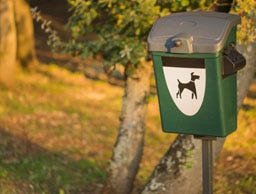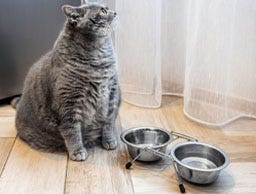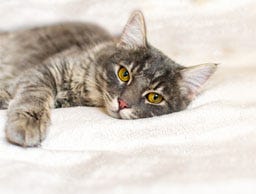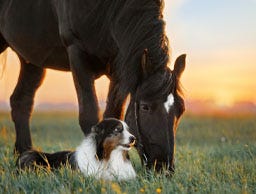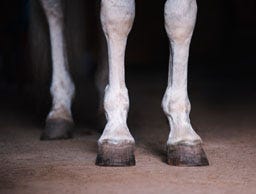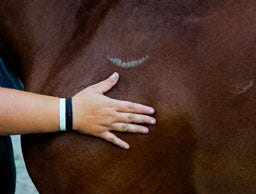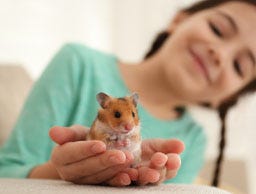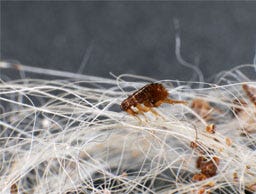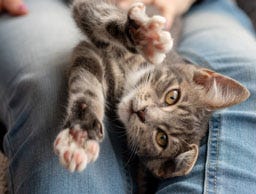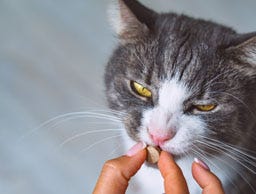The Ultimate Guide to Pet-Friendly Plants
Plants are a vital part of any ecosystem, so it’s no wonder we spend so much time cultivating the perfect garden, growing our own food, or even decorating our homes with plants. However, not all plants are as safe as they appear, and many can even be toxic to humans and animals.
In this guide, we look at the broad range of pet-safe plants that you can grow or plant in your garden or home without worrying about your furry friends' well-being.
Contents:
Understanding Plant Names
Before we discuss our recommendations for pet-friendly plants, it is important to understand how plants get their names and how to read them. While many plants are known by their common names (daisy, bamboo, aloe vera), they have scientific names that follow the Binomial Nomenclature system to differentiate between species. In this system, plants and animals are given a scientific name consisting of the genus and the species, allowing us to identify the specific plant or animal.
Think of it like dogs. We all know what a dog is, often just by looking, but the breed of dog determines its characteristics, like coat type or colour. This is important to understand because some plants share common names, but the scientific or botanical name of the plant will determine if it’s safe for pets or not, and if not, how dangerous ingesting it is. You should be able to find the scientific name for a plant on the label before you buy it, or on the seed packaging if you’re planning to grow your own.
Please note, while all the plants named in this article are generally considered pet-safe, this does not mean your pet will have no reaction to eating it. Any plant may cause mild to moderate digestive problems if eaten by animals. Ingesting toxic plants, however, can cause much more severe and potentially life-threatening damge.
Pet-Friendly Indoor Plants
Bringing plants into your home is the perfect way to liven up any space, adding splashes of colour where needed, or reaping the benefits of their air-purifying properties. But finding the right plants for your home can be a struggle as many are toxic to pets if ingested or can cause allergic reactions when touched.
Below, we outline some of the best pet-friendly houseplants.
Pet-Friendly Flowers Indoors
Flowers are a beautiful addition to any home, whether you grow them in a planter or have them cut in a vase. But with so many flowers causing toxic reactions in pets, it can be hard to know what ones are safe for pets.
Orchids (Phalaenopsis spp.)
One of the best non-toxic flowers to have indoors is the orchid. These tall and elegant plants can be found almost anywhere in the world, and produce sprigs of beautiful flowers in various shapes and colours. Phalaenopsis orchids (Moth Orchids) are listed on the ASPCA site as non-toxic to cats and dogs.
Freesias (Freesia spp.)
Freesias are one of the most popular flowers to cut and add to bouquets, but you can also grow them indoors. They have beautiful spring-like blooms in colours from white and pale purple to yellows and oranges. While these plants are native to South Africa, they can be grown in the UK so long as they’re kept in a bright, cool room. Freesias are loved for their sweet scent and long vase life, making them a stunning addition to any home. Freesia flowers, stems, and leaves are generally considered non-toxic to cats and dogs. However, the bulbs can be toxic to humans and animals, so ensure you keep these stored safely out of reach if you choose to grow your own.
African Violets (Streptocarpus ionanthus)
Another popular indoor flower for pet owners is the African Violet. These small shrubby plants have lovely fuzzy leaves and produce sprigs of little purple flowers. They are non-toxic to both cats and dogs. However, some cats are particularly drawn to these plants because of their leaves, so keeping them out of reach is the best way to ensure healthy plants and pets.
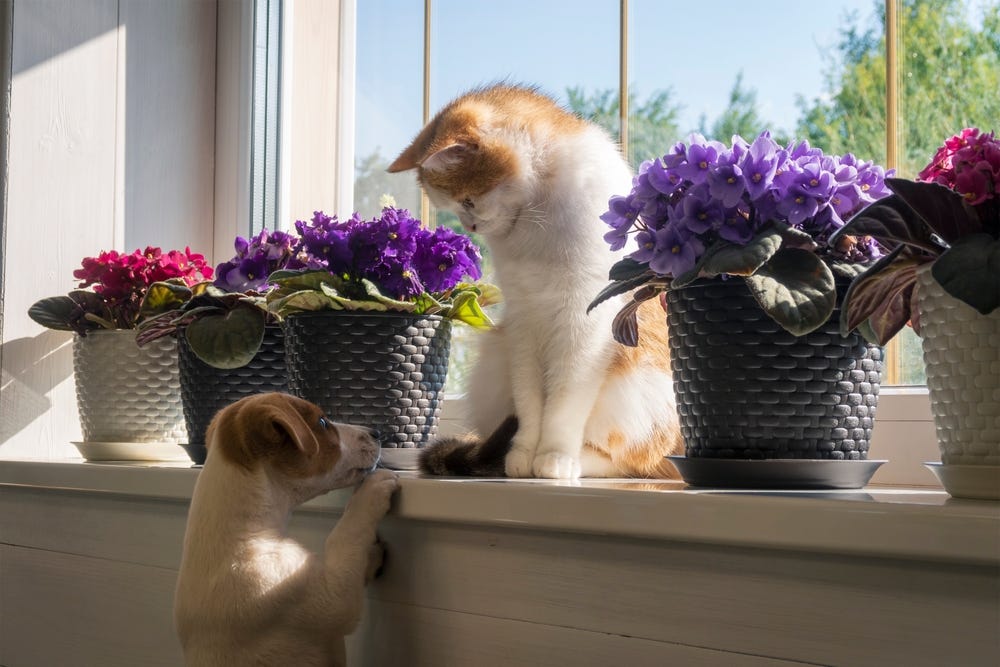

Pet-Safe Houseplants
Calathea (Calathea spp)
Members of the Calathea family are stunning plants with bright and vibrant, often patterned foliage. Many Calatheas have fishbone-like markings in various shades of green on their leaves and are a rich purple underneath. While visually striking, these plants are also well known for their air-purifying properties, and most are non-toxic to pets!
Calatheas can be tricky to care for if you’re not familiar with their needs, but with the proper attention, they make stunning houseplants. Just ensure they get plenty of indirect sunlight and feed them monthly during spring and summer.
Spider Plant (Chlorophytum comosum)
Another plant known for its air-purifying qualities is the spider plant, a popular houseplant because of its narrow, cascading foliage that droops over the side of their containers. Spider plants are beginner-friendly houseplants that can thrive with little attention and are generally considered non-toxic to cats and dogs. You can even hang a spider plant in a hanging planter to keep it away from your furry friends, but bear in mind that spider plants' shoots will hang down, which can be tempting to cats looking for something to play with.
Palm Varieties
A palm plant could be the answer if you want a more tropical or wild vibe. They’re resilient houseplants with long, thin stems tipped with luscious green leaves. They’re hardy plants that do well in low-light areas and don’t need frequent watering. You must be careful when choosing a palm plant, as some of them, like the Sago Palm (Cycas revoluta), are fatally toxic to cats if ingested, so always check the scientific names when looking for a pet-safe palm.
If you’re looking for a palm to add to your home that is also safe around pets, your best picks are the Parlor Palm (Chamaedorea elegans) or the Areca Palm (Dypsis lutescens)
String of Hearts (Ceropegia woodii)
If hanging plants are your vibe, look no further than the string of hearts. While technically a succulent, the string of hearts gets its name from the long trails of heart-shaped leaves that spill over the side of its pot. They’re perfect for hanging or sitting on a shelf where the leaves can cascade downwards. It is also easy to care for since they don’t need much water and thrive in bright indirect light, so the string of hearts is also pet-safe! Be wary of where you put it, as those dangling leaves can be very enticing for cats to bat.
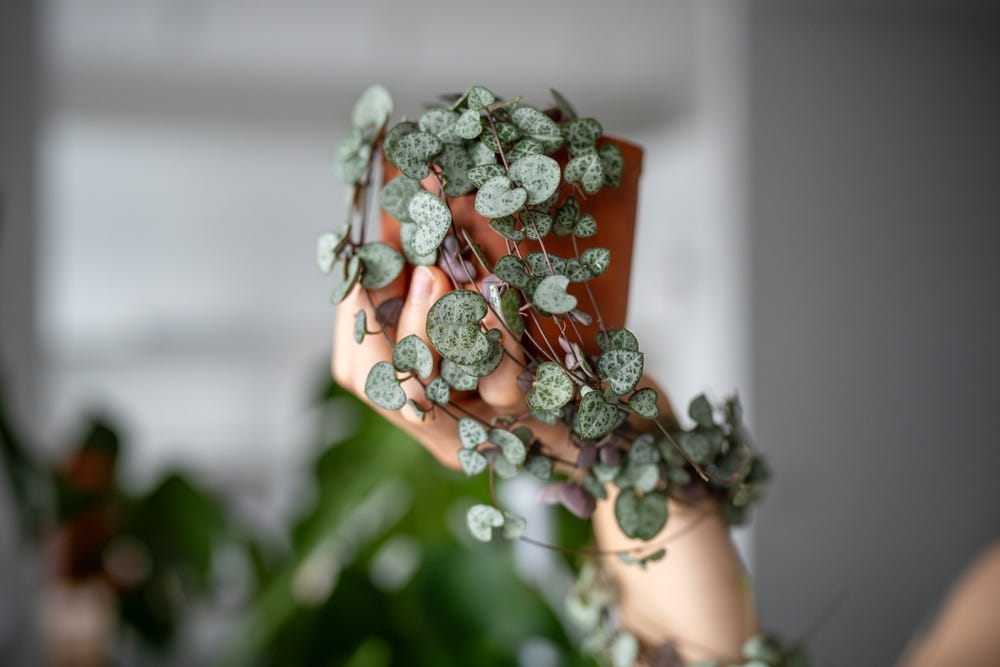

Pet-Friendly Outdoor Plants
The plants you choose to grow in your garden should be a reflection of you and your home, so if you’re a pet owner, there’s a few things to bear in mind. Firstly, you should always choose plants that are non-toxic, but also hardy and robust plants that can survive the strain of sniffing, pawing, or the odd nibble.
Pet-Friendly Garden Flowers
Thankfully, there are plenty of flowers that you can grow in UK gardens that are non-toxic to cats and dog, including:
Roses (Rosa spp.)
A classic addition to any garden, who could turn their nose up at a rose? These timeless beauties come in various colours, from palest pink to deepest red, and they’re also non-toxic to dogs and cats. Roses also come in various forms, from the traditional shrub to climbing roses and even miniature roses for potting. However, every rose has its thorns; in this case, we mean the actual thorns on the plant. Thorns can drop off roses, which can be painful if stepped on or swallowed by pets, so always make sure to monitor your pet around rose plants, or you can de-thorn your rose to protect your pets.
Sunflowers (Helianthus annuus)
Another bright and sunny addition to any garden, you’ll be happy to know that sunflowers are also non-toxic to pets. Sunflowers grow quickly,and the plants can reach between 2.5 and 4 metres, and the large, daisy-like flowers spread up to 30cm across, attracting bees and other pollinators to your garden. Plus, when the flowers die, you’re left with a full head of sunflower seeds to keep as an easy snack, or you can use them as bird seeds!
Snapdragons (Antirrhinum majus)
The snapdragon is a stunning perennial plant from the Mediterranean that flowers throughout the spring, summer, and even autumn. However, it does not tolerate cold very well. Snapdragons are non-toxic to cats and dogs and produce fragrant flowers that vary from pinks and purples to shades of blue and orange, giving your garden a real spark of colour.
Lavender (Lavandula spp.)
Well known for its supposed calming properties, lavender is also non-toxic to both cats and dogs and is a popular plant for pollinators like bees and butterflies. Hardy, long-lived and drought-tolerant, lavender makes a great addition to any plant border or even herb garden, since it’s technically a member of the mint family. They flower fragrantly in early summer with colours varying from the classic purple to white, pink, or blue, and have silvery-green leaves.
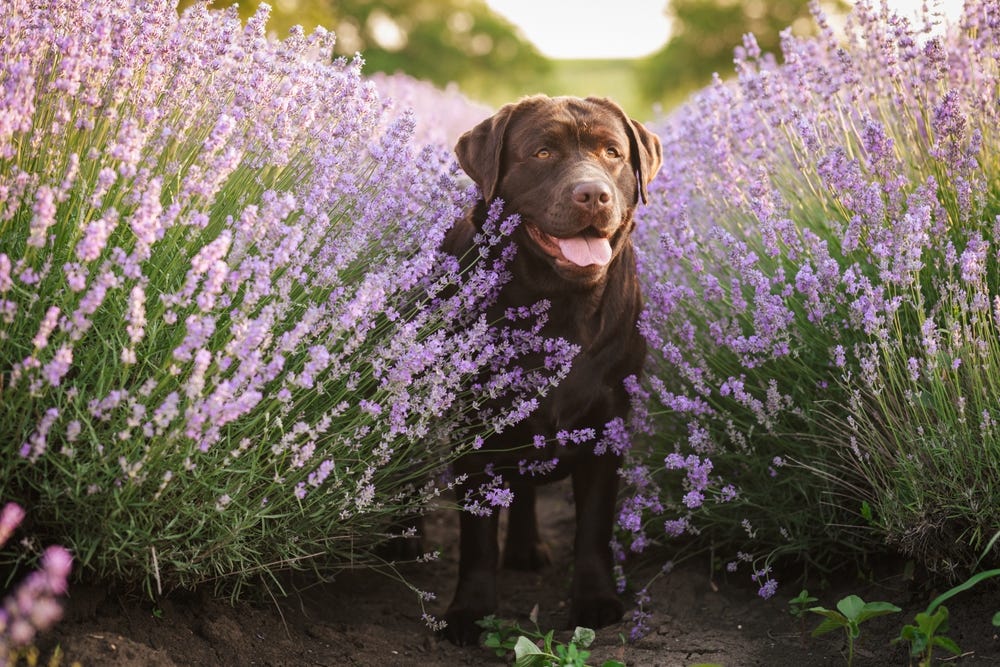

Pet-Friendly Herbs
If you love the idea of growing your own herbs, then you’re in luck! Many herbs are entirely non-toxic to pets, and some even have enriching effects on certain species (we're looking at you, Catnip), so it only makes sense that herbs would be a crucial part of any pet-friendly or sensory garden. Below are some of the best pet-safe herbs to grow in your garden.
Catnip (Nepeta cataria)
It should be no surprise that the catnip plant is safe for cats and dogs. As a member of the mint family, this herb has aromatic leaves and small white flowers. Crushing or tearing the triangular leaves releases the compound nepetalactone, which causes a playful or “crazy” reaction in cats. While the catnip in cat toys is typically dried, having a catnip plant in your garden can offer great enrichment to your pets, but may come at the cost of neighbourhood cats being very interested in your garden.
Thyme (Thymus vulgaris)
Thyme has a long medicinal history, having been used by herbalists for centuries to help with respiratory problems and even gastrointestinal upset. Now more commonly used for its culinary uses, thyme is still a great addition to any herb garden and is non-toxic to cats and dogs. They have aromatic leaves in dark grey-green colours and spikes of small white flowers in the early summer. The plant rarely grows bigger than 30cm tall or 40cm wide, making it a great potting plant for a garden or kitchen windowsill.
Lemon Balm (Melissa officinalis)
Another pet-safe herb that makes for a great garden addition is lemon balm. Originating in the Mediterranean region and Central Asia, this herb has been used for centuries for its calming properties. It is also used in certain veterinary medicines to ease digestive upsets, such as vomiting and diarrhoea. Lemon balm typically has creamy-white spikes of fragrant leaves that smell of lemons, with pale purple flowers full of nectar that will attract pollinators to your garden.
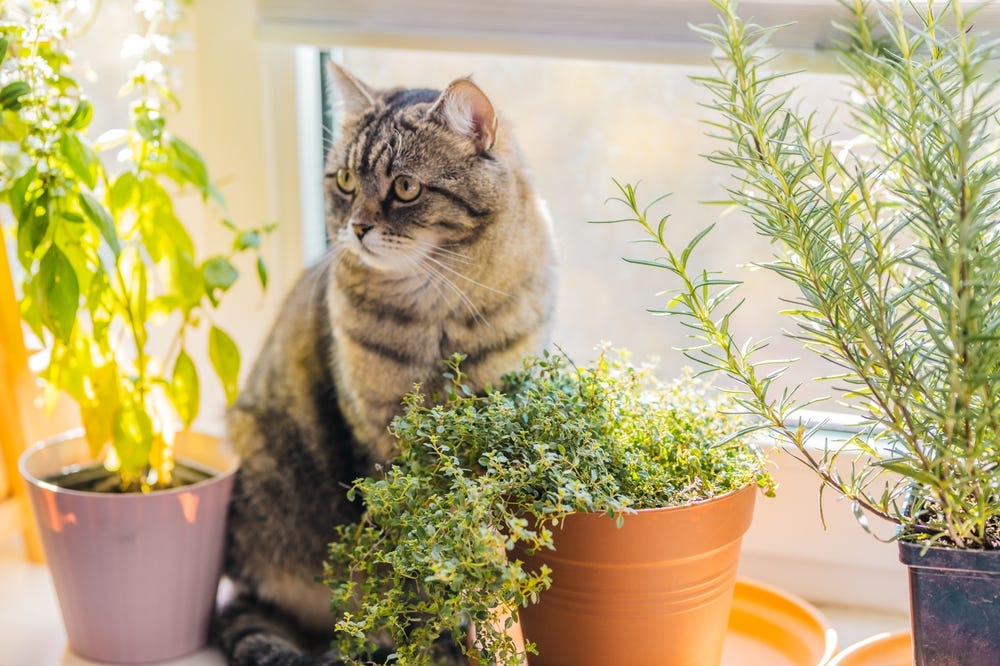

By picking pet-safe plants and flowers for your garden, you can ensure your furry friends stay safe while also offering a range of enriching smells to create a sensory haven for them. Always monitor your pets when they're in the garden to protect them from eating things they shouldn't and ensure the safety and longevity of your plants.
Also, be sure to protect your pet from parasites while they're out in the garden with our great range of flea, tick, and worming treatments available now from top brands like Advantage™, FRONTLINE®, and more!


This post is an opinion and should only be used as a guide. You should thoroughly discuss any change to your pet’s care or lifestyle with your vet before starting any program or treatment.




























